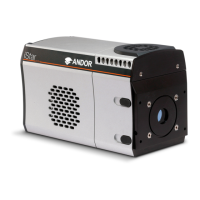2.8 - COOLING
The New iStar detector is cooled using a thermoelectric (TE) cooler which is a small, electrically powered devices with
no moving parts, making it very reliable and convenient. A TE cooler acts as a heat pump, i.e. it achieves a temperature
difference by transferring heat from its ‘cold side’ (the CCD-chip within the New iStar camera head) to its ‘hot side’ (the
built-in heat sink).
Therefore the minimum absolute operating temperature of the New iStar sensor depends on the temperature of the heat
sink. The advanced thermal design of the New iStar means that a maximum temperature difference of over 60ºC can be
achieved. The maximum temperature difference that a TE device can attain is dependent on the following factors:
• HeatloadcreatedbytheCCDsensor,ber-opticcouplingtotheintensierandcameraheaddesign
• NumberofcoolingstagesoftheTEcooler
• Operatingcurrent
• OperatingtemperatureofTEcooler
The minimum temperature, to which the sensor within the New iStar can be cooled, will be dependent on either the room
temperature (when air-cooling is employed) or the coolant temperature circulating through the heat sink (when liquid
cooling is utilized).
2.8.1 - Air Cooling
Air cooling is the most convenient method of removing heat from the detector head, but it will not achieve as low an
operating temperature as water cooling. Even with a fan, a heat sink typically needs to be 10ºC hotter than the ambient
(room) temperature to transfer heat efciently to the surrounding environment. Therefore the minimum CCD temperature
that can be achieved will be dependent on the room temperature.
The table below is a guide to the minimum achievable cooling for various ambient temperatures. Performance of
individual systems will vary slightly.
Table 1: New iStar air cooling performance versus image intensier size
Notes:
1. The relationship between the air temperature and the minimum CCD temperature in the table is not 1:1.
This is because TE coolers become less efcient as they get colder
2. System cooling performance should be considered in terms of the minimum dark current achievable,
rather than absolute temperature. For dark current specications, please refer to the specication sheet
for your camera
Air Temperature CCD Temperature
mm mm
20ºC -30ºC -25ºC
30ºC -25ºC -20ºC
40ºC -20ºC -15ºC
Introduction to the New iStar

